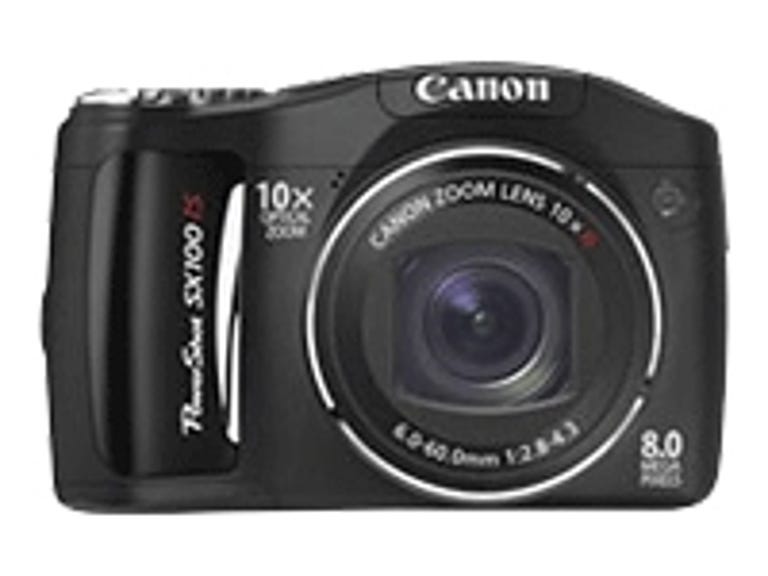 Why You Can Trust CNET
Why You Can Trust CNET Canon PowerShot SX100 IS review: Canon PowerShot SX100 IS
Canon PowerShot SX100 IS
The magic number for megazoom cameras seems to be 300--dollars, that is. Canon's last-generation PowerShot S3 IS remains quite popular despite the release of a new model, the S5 IS, while similarly priced competitors, such as the Panasonic Lumix DMC-TZ3 and Kodak EasyShare Z712 IS garner lots of attention from CNET readers. So it should be unsurprising that both Canon and Sony decided to release models specifically targeting that magic price. Canon's PowerShot SX100 IS slips into the market a tad later than Sony's Cyber-shot DSC-H3, but like that model inspires more thoughts about its tradeoffs than its attractions.
The Good
The Bad
The Bottom Line
I have to admit, one of the SX100's biggest lures is its relatively compact size. Though still relatively large compared with the smaller megazooms like the H3 and the TZ3--it weighs 11 ounces and will fit into a jacket pocket, at best--it's still considerably smaller than the 1-pound-plus S5 and S3. Part of the size savings likely stems from the shorter, though still optically stabilized, 10x f/2.8-4.3, 36mm-360mm zoom lens (compared with 12x for its bigger brothers). However, it uses the same 8-megapixel sensor and 2.5-inch LCD as the S5 IS.
The camera remains large enough to hold comfortably, though the grip itself could be a smidgen bigger and a lot less slippery. Encased in plastic, the SX100 nevertheless feels quite solid and sturdy. It also has a far more efficient layout than its siblings, with little sacrifice of shooting controls. And a big "yay!" for the electronic lens cover--there's no reason we should still have to suffer with those dangling plastic annoyances that pop off when you don't want them to and don't pop off when you do. A mode dial and zoom switch sit on top of the camera, with PictBridge, face detection, and display and menu buttons beneath the LCD. To the right of the display, a navigational scroll wheel has top, bottom, left, and right pressure points for ISO, focus (manual and macro), flash, and drive mode. Dedicated exposure compensation and review buttons plus a Func button to pull up shooting settings, round out the controls. I'm usually a big fan of scroll wheels, but I find the SX100's maddening: a mistaken twitch of the finger and I frequently end up clicking on one of the four options instead of scrolling through shutter speeds.
To give Canon credit, the SX100 retains many of the controls found in the S3 and S5; manual controls tend to fall by the wayside in this camera class. There's still a full complement of manual and semimanual exposure modes, flash and exposure compensation, and three-metering modes. There's also the de rigueur handful of scene modes, plus a decent face detection mode that lets you scroll through found faces to select one. It still takes longer to use than simply picking a face and focusing on it.
You do forgo an electronic viewfinder, support for add-on lenses, and a hot shoe with the SX100, though I doubt many potential users would really miss any of them. More irritating is the downfeatured movie capture mode. It does VGA, 30fps movies, but optical zoom doesn't work while shooting them, and the nice separated stereo mics of the S3 and S5 have been replaced with mono sound.
While the SX100 gets decent marks overall for speed, it does have some borderline performance issues that earned it some ratings demerits. It wakes and shoots in a reasonable 2 seconds. Its shutter lag for high- and low-contrast scenes--0.5 second and 1.7 seconds, respectively--are typical for this class, as is its 1.7-second typical shot-to-shot time. However, shot-to-shot time jumps to 4.3 seconds once you enable the flash, a seriously slow figure we haven't seen for several years. And burst shooting runs a mere 0.8 frame per second, which barely exceeds the single-shot shooting speed. Finally, the LCD is good, but not terrific, and not always easy to see in bright sunlight.
What the camera sacrifices in speed, however, it makes up for in photo quality. Perhaps it's just the result of an extra few months of tweaking since the S5 shipped, but the SX100's photo quality, especially at higher ISO sensitivity settings, clearly improves upon its siblings. At ISO 800, for example, there's far less of a mottled look in the SX100's shots, but with no increased loss of detail. The new lens has better distortion characteristics--less distortion and more symmetry--and photos look sharp without looking oversharpened. While there's a bit of magenta, yellow, and purple fringing, it's not nearly as severe in the SX100's photos as those of the S5 (or S3). Plus, the good aspects of those models' images--predominantly excellent exposure and color--highlight the SX100's photos, as well.
Despite its arguably best-in-class photo quality, the Canon PowerShot SX100's spotty performance, disappointing movie capture, and occasionally frustrating design keep it from earning a no-brainer recommendation.
(Smaller bars indicate better performance)
| Typical shot-to-shot time | Time to first shot | Shutter lag (dim) | Shutter lag (typical) |
(Longer bars indicate better performance)



